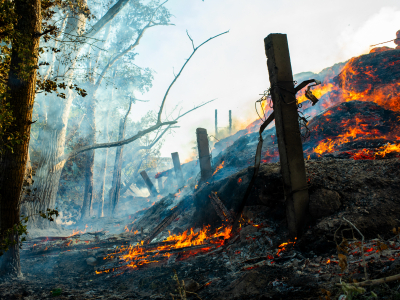
Audit Objective
In our first performance audit report, Bushfire prevention and preparedness (Report 10: 2014–15), we examined whether Queensland was better able to prevent and prepare for bushfires following the 2009 Victorian Bushfires Royal Commission, the Malone Review into Rural Fire Services in Queensland 2013, and the (Queensland) Police and Community Safety Review 2013.
In this follow-up audit, we examined whether Queensland Fire and Emergency Services has effectively implemented the recommendations we made in our first report. We also assessed whether the actions taken have addressed the underlying issues that led to our recommendations in that report.
Overview
Australia experiences many large, devastating natural disasters, including catastrophic bushfires. Since 1901, over 700 civilians and 90 firefighters have lost their lives, and over 11 000 homes have been destroyed, in bushfires across Australia.
Queensland's bushfire threat is not as acute as in Australia's southern states. However, current research indicates bushfire seasons will lengthen in the coming decade and fire frequency and intensity may increase.
Audit results
Queensland Fire and Emergency Services (QFES) has made efforts to address the underlying issues we identified in our original 2014 audit. Through several initiatives, including establishing the Office of Bushfire Mitigation and area fire management groups, it has increased its focus on bushfire risk mitigation activities statewide. It has also improved its engagement with key stakeholders and is now able to better coordinate and manage Queensland’s bushfire risk.
Despite these efforts, more work is needed to ensure Queensland communities are not exposed to higher levels of risk than they need to be. In response to our original audit, QFES committed to implement the agreed recommendations by 2015, but in this audit we found it has not yet fully implemented any of the recommendations. We acknowledge that fully implementing the recommendations is a challenge where contribution by multiple parties is required to complete them. For example, QFES in many cases is reliant on the actions of others—volunteers, other state agencies, or the federal government—to fully implement the recommendations.
QFES has not fully rolled out its new risk mitigation systems and tools across all regions. And more training and continuous improvement is needed to make sure they are effectively used to strengthen Queensland’s approach to risk mitigation.
It is critical that QFES’s efforts to improve its collaboration with key stakeholders continue. In particular, it should continue to engage with land managers and local governments to better identify bushfire risks and prioritise mitigation activities. Further improvements and use of evaluation systems are needed to measure the effectiveness of mitigation activities and identify improvement opportunities across Queensland. Better engagement with local communities is also needed to understand their risks and help them prepare for bushfires. These actions will enhance the ability of QFES to manage and respond to bushfires, and make our communities safer.


